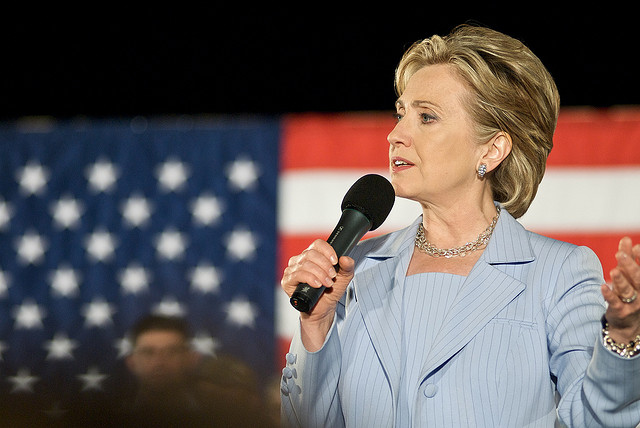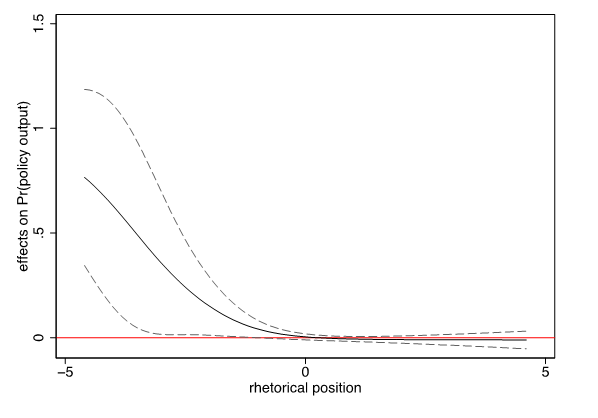Party rhetoric isn’t usually empty talk, and tends to accurately reflect political and policy positions
Should political rhetoric be understood merely as symbolic but essentially empty talk? Using data on party rhetoric about the usage of nuclear energy after the Fukushima catastrophe across twelve countries, Daniel Bischof shows that rhetorical party positions appear to be strongly structured around party manifesto positions and that parties ‘walk like they talk’ with their policy efforts largely correlating with their rhetorical positions.

Possible Presidential candidate Hilary Clinton (Credit: Keith Kissel, CC BY 2.0)
Politicians reach out to the public to an enormous extend with „talk“: candidates duel each other in TV, parliamentarians fight with words during debate sessions, politicians answer questions by the press and hold speeches at all kinds of public gatherings. Interestingly, research on policy information delivered through such rhetorical activities is limited and often bound to campaign periods or other very distinctive points in time during a legislative cycle – such as the Queen’s speech in Britain. Until today party positions are largely derived from party manifestos and expert surveys. Thus, parties’ positions in between elections are less frequently studied and often remain a “black box”. While the research undertaken by the comparative agenda project contributed eminently to fill this gap by analysing when and why parties talk about which issue, their data capture issue attention and not parties’ actual policy positions – e.g. whether a party supports or rejects the usage of nuclear energy. Only recently scholars have started to appreciate media coverage of party activities as a potential source to study parties’ position taking in between elections. However, how resilient party rhetorics are and whether or not parties aim to implement their rhetorics have remained open questions.
Party manifestos and rhetoric
I argue that voters are likely to judge parties based on information, which is cheap and simple to access. Instead of using time and effort to read and understand lengthy party manifestos, voters rely on policy cues they receive on a daily basis via the media. In fact, today voters might not even seek such information, but just randomly are set out to party rhetoric via one of the several media channels they use (e.g. internet, twitter etc.). Parties are understood to have an incentive to provide a clear-cut message to voters and in most instances to stick to agreed party positions put forward in party manifestos, since voters are likely to punish flip-flopping positions at the ballot box.
To test the relationship between party rhetorics and their manifesto positions, I rely on the ResponsiveGov project data. The project collects data by manual coding of the content of a country’s main newswire, as well as legislative and parliamentary databases. Coders are instructed to follow the rules of a detailed codebook to assure consistency across coders. They are also asked to place any party activity on pre-defined scales describing whether a party is in favour of or against nuclear energy. From these data, I derive a monthly measurement of parties’ rhetorical positions on the usage of nuclear energy (Please consult the paper for a more detailed reasoning).
My analysis reveals that across 67 parties in 12 countries party rhetorics on nuclear energy are significantly related to parties’ initial manifesto positions. This lends support to the assumption that parties indeed largely stick in their rhetorics to their manifesto positions, which have been previously arranged amongst a larger part of all party members.
Do they walk like they talk?
However, the question remains whether or not party rhetoric is sheer symbolism or represents cues for parties’ policy efforts. In order to test whether party rhetoric is congruent with parties’ policy outputs (e.g. bills, legislative acts, laws and policy proposals), I conducted logistic regression analyses with parties’ anti-nuclear policy outputs as the dependent variable (Please consult the paper for a more detailed reasoning). The results show that parties’ talk is mostly in line with their policy outputs: the more anti-nuclear a party talks, the more likely it is to push for congruent policy alteration on the parliamentary floor. Furthermore, in line with previous research I assume that parties in office have their reliability (consistency between promise and performance) more severely tested than the opposition”.
Thus, government parties are likely to share rhetorical positions which they subsequently can follow suit. Thereby parties try to prevent any subsequent punishment by the voter at the ballot box. Figure 2 reports exactly this mediation effect of parties’ incumbency status: the more anti-nuclear incumbent parties talk (negative values on the x-axis), the higher their probability to deliver congruent anti-nuclear policy outputs (y-axis). In contrast, the talk of incumbent parties supporting nuclear energy does not have any significant effect on their policy output (positive values of the x-axis). Both of these effects are stable across several statistical model specifications, when I control for party size (seats held in parliament), and the specific role green parties might play on the nuclear issue.
Figure 2: The moderating effect of incumbency on party rhetoric
Conclusion
It appears that parties’ talk on the nuclear issue can be understood as more than sheer symbolism: it can serve as means to share important policy cues with the public. Thus, the data we can derive from coverage of party talk in the media should help us to extend research beyond the given temporal limitations of party manifestos and expert surveys. On top of that, parties do not say one thing and then do another, at least not in the case of nuclear energy policy making after the Fukushima meltdown. Yet, in some instances parties deviate from their initial manifesto positions. My PhD thesis tries to disentangle these deviations. It aims to understand when and why parties shift their rhetorical positions due to external influences, such as demonstrations, public opinion switches or external shocks (e.g. the Fukushima meltdown).
—
Note: This piece is a summary of a working paper that was presented at the general conference of the European Consortium for Political Research (ECPR) and the annual Elections Public Opinion and Parties (EPOP) conference, entitled „Cheap Talk or Keeping/Making Promises? Party Rhetorics Between Elections“. It represents the views of the author, and not those of Democratic Audit or the LSE. Please read our comments policy before posting.
—
 Daniel Bischof is a PhD candidate in comparative politics within Prof. Laura Morales’ ResponsiveGov project at the University of Leicester. His research is particularly interested in political parties, especially responsiveness of political parties to protest and public opinion, the impact of repression on collective action, and quantitative methods. He graduated in political science from the University of Bamberg in 2012.
Daniel Bischof is a PhD candidate in comparative politics within Prof. Laura Morales’ ResponsiveGov project at the University of Leicester. His research is particularly interested in political parties, especially responsiveness of political parties to protest and public opinion, the impact of repression on collective action, and quantitative methods. He graduated in political science from the University of Bamberg in 2012.






 Democratic Audit's core funding is provided by the Joseph Rowntree Charitable Trust. Additional funding is provided by the London School of Economics.
Democratic Audit's core funding is provided by the Joseph Rowntree Charitable Trust. Additional funding is provided by the London School of Economics.
Is party rhetoric only empty talk? @DanBischof on party rhetoric from the LSE Audit blog https://t.co/oyLhVfrKTJ @democraticaudit @lauramdu
Do parties ‘walk like they talk’? https://t.co/zNJmv58Zs2
Our own @DanBischof of @Responsivegov_P on @democraticaudit
CC @PoliticsLeicsU
Do parties ‘walk like they talk’? https://t.co/zNJmv58Zs2
Our own @DanBischof of @Responsivegov_P on @democraticaudit
CC @ERC_Research
“Government parties are likely to share rhetorical positions which they subsequently can follow suit” https://t.co/Ak9kQxDRfY
[…] https://www.democraticaudit.com/?p=8954 […]
Check out my first contribution to the LSE’s @democraticaudit blog:
https://t.co/dNwBthpeXh
Party rhetoric isn’t usually empty talk, and tends to accurately reflect political and policy positions https://t.co/5XLw1TQNH6
Party rhetoric isn’t usually empty talk, and tends to accurately reflect political and policy positions https://t.co/EmbXjFmgSC